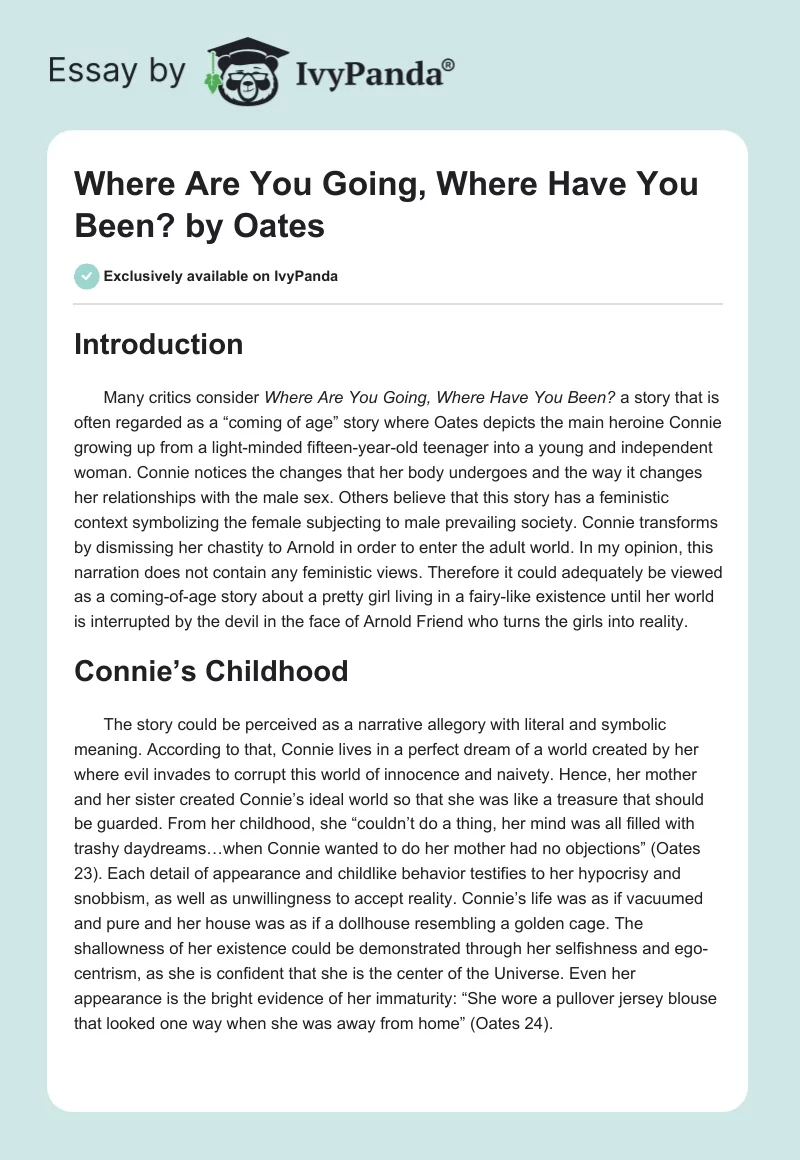Introduction
Many critics consider Where Are You Going, Where Have You Been? a story that is often regarded as a “coming of age” story where Oates depicts the main heroine Connie growing up from a light-minded fifteen-year-old teenager into a young and independent woman. Connie notices the changes that her body undergoes and the way it changes her relationships with the male sex. Others believe that this story has a feministic context symbolizing the female subjecting to male prevailing society. Connie transforms by dismissing her chastity to Arnold in order to enter the adult world. In my opinion, this narration does not contain any feministic views. Therefore it could adequately be viewed as a coming-of-age story about a pretty girl living in a fairy-like existence until her world is interrupted by the devil in the face of Arnold Friend who turns the girls into reality.
Connie’s Childhood
The story could be perceived as a narrative allegory with literal and symbolic meaning. According to that, Connie lives in a perfect dream of a world created by her where evil invades to corrupt this world of innocence and naivety. Hence, her mother and her sister created Connie’s ideal world so that she was like a treasure that should be guarded. From her childhood, she “couldn’t do a thing, her mind was all filled with trashy daydreams…when Connie wanted to do her mother had no objections” (Oates 23). Each detail of appearance and childlike behavior testifies to her hypocrisy and snobbism, as well as unwillingness to accept reality. Connie’s life was as if vacuumed and pure and her house was as if a dollhouse resembling a golden cage. The shallowness of her existence could be demonstrated through her selfishness and ego-centrism, as she is confident that she is the center of the Universe. Even her appearance is the bright evidence of her immaturity: “She wore a pullover jersey blouse that looked one way when she was away from home” (Oates 24).
Role of Antagonist
In the story, Arnold Friend, Connie’s antagonist, helps Connie to enter reality. This character is created by the author is for the reader to understand what challenges and adversities Connie had to overcome in order to become a woman and to enter adult society. When facing the pure evil in the face of Arnold, Connie realizes that her absolute power over the boys is a trifle and in fact, she is weak enough to endure pressure as equally as the adults do. Connie realizes that her power and ability to control others is false; her actions and behavior fail to conform to the rules of reality so that she gradually loses control over her imaginary world. This encounter could be also regarded as Connie’s transition from a naughty teenager into a young woman experiencing male power. The heroine is at a loss, as this new world does not conform to her “trashy dreams” and frustrates all her ideas about male-female relationships.
The author portrays the ignorance of the girls deprived of the feeling of reality and of the evil men who take advantage of the innocence thus despising the issues of chastity. In that regard, Arnold Friend is depicted as a universal image of all men where all details of his appearance and behavior seem to be devilish, even the face “was a whole mask” as if “he were smiling from inside a mask”(Oates 24). By means of this image, the author involves Connie in the reevaluation process thus making her perceive the fate of the females in this male-dominating world. Now, being in the power of the devil, Connie feels as if she is deprived of her previous privileges; here she faces the real threat of male superiority. In order to become an adult, she has to sacrifice her innocence, but this transition does not seem good for her, as it is filled with evil. Connie understands that her body does not belong to her, as her mind is still a mind of a child. Her lack of awareness does not allow her to accept the inevitability of growing up; instead, she encounters a new unknown world, which destroys her moral values.
End of Transformation
The story also conveys Oates’s personal outlook on being a woman at that time. Hence, the author believes that as a woman it is necessary to be subjected to a male world. At the final stage of transformation, Connie confronts the extreme necessity to become an adult, as this patriarchal is adopted only for mature women deprived of innocence and purity. Arnold’s lies and deceitful appearance confuse Connie understand that the world and even her home seems alien to her: “The kitchen looked like a place she had never been before, some room she had run inside but that wasn’t good enough, wasn’t going to help her” (Oates 28).
Conclusion
Where Are You Going, Where Have You Been? is a realistic allegory about women’s fate in the American society of that time. The author, here, renders females and males opposing each other thus standing the good and the evil side correspondently. Therefore, she portrays men as pure evil that try to oppress female nature and establish their moral and social norms.
Works Cited
Oates, Joyce Carol. Where are you going, where have you been? US: Rutgers University Press, 1994.


